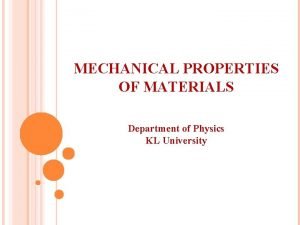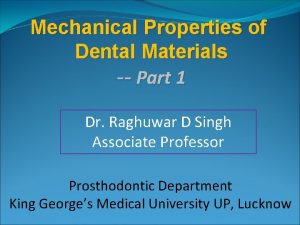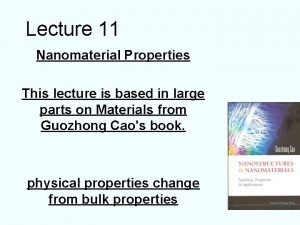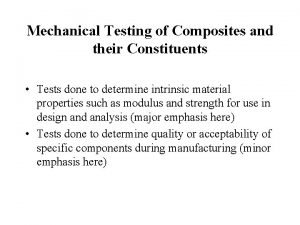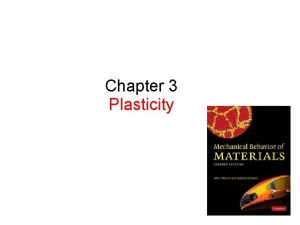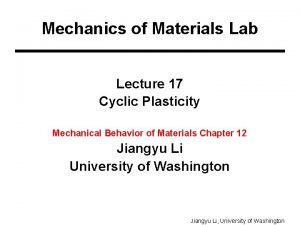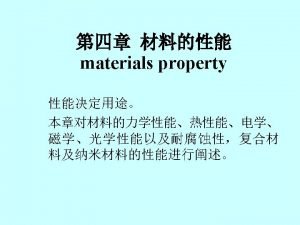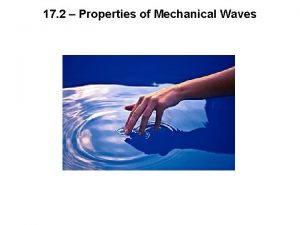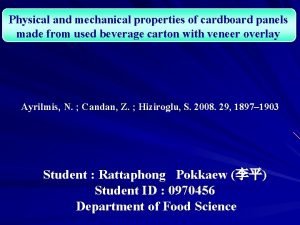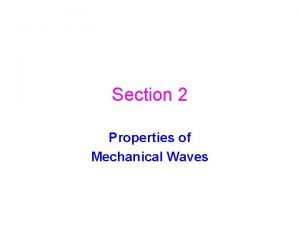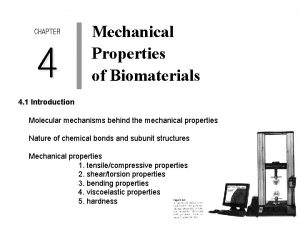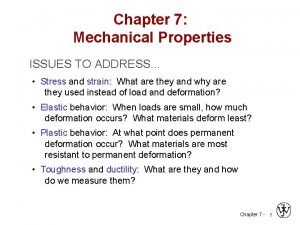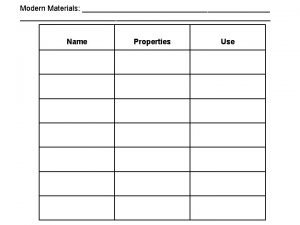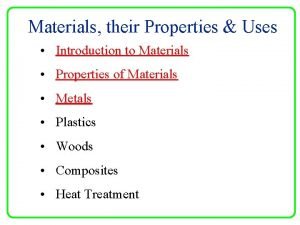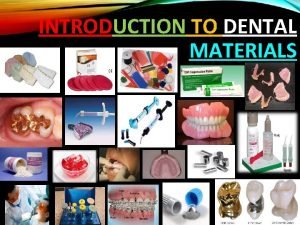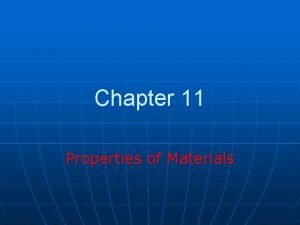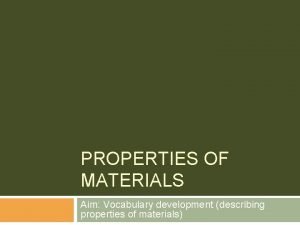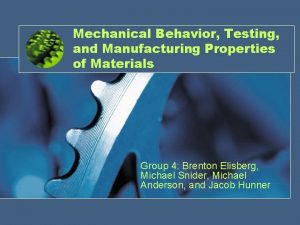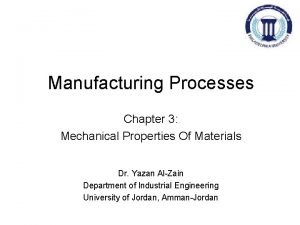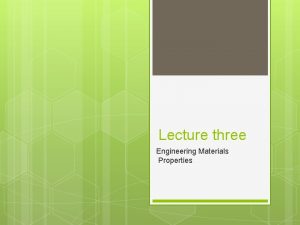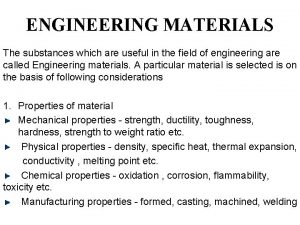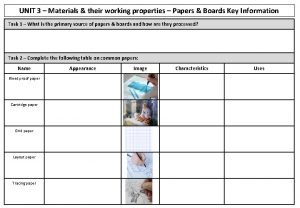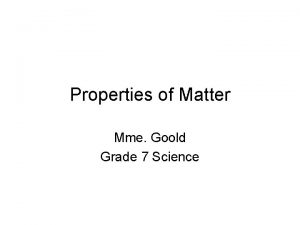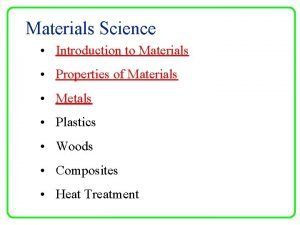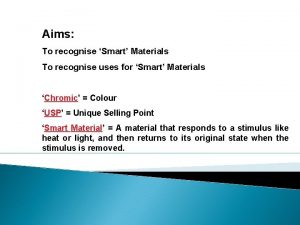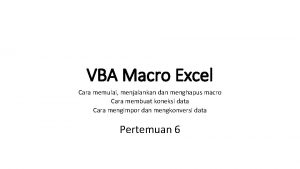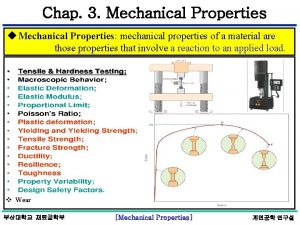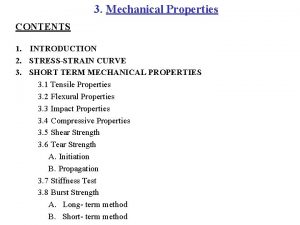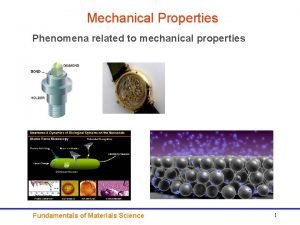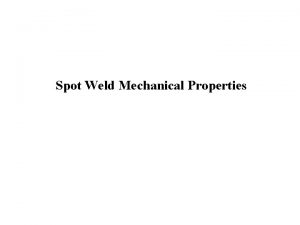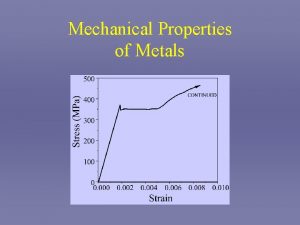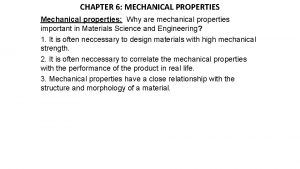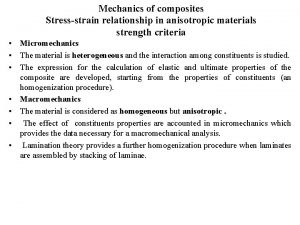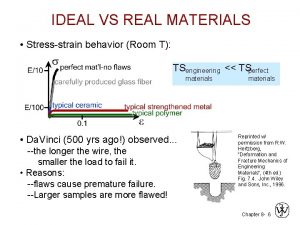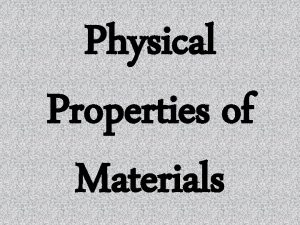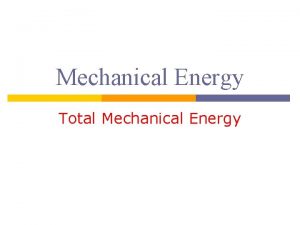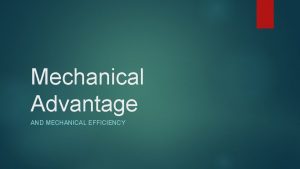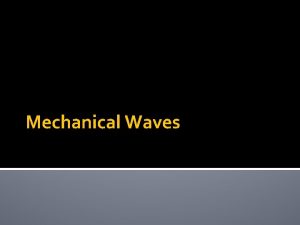MECHANICAL PROPERTIES OF MATERIALS 1 StressStrain Relationships 2007








































- Slides: 40

MECHANICAL PROPERTIES OF MATERIALS 1. Stress‑Strain Relationships © 2007 John Wiley & Sons, Inc. M P Groover, Fundamentals of Modern Manufacturing 3/e

Mechanical Properties in Design and Manufacturing Mechanical properties determine a material’s behavior when subjected to mechanical stresses § Properties include elastic modulus, ductility, hardness, and various measures of strength § Dilemma: mechanical properties desirable to the designer, such as high strength, usually make manufacturing more difficult § The manufacturing engineer should appreciate the design viewpoint § And the designer should be aware of the manufacturing viewpoint © 2007 John Wiley & Sons, Inc. M P Groover, Fundamentals of Modern Manufacturing 3/e

Stress‑Strain Relationships Three types of static stresses to which materials can be subjected: 1. Tensile - tend to stretch the material 2. Compressive - tend to squeeze it 3. Shear - tend to cause adjacent portions of material to slide against each other § Stress‑strain curve - basic relationship that describes mechanical properties for all three types © 2007 John Wiley & Sons, Inc. M P Groover, Fundamentals of Modern Manufacturing 3/e

Tensile Test Most common test for studying stress‑strain relationship, especially metals In the test, a force pulls the material, elongating it and reducing its diameter Figure 3. 1 Tensile test: (a) tensile force applied in (1) and (2) resulting elongation of material © 2007 John Wiley & Sons, Inc. M P Groover, Fundamentals of Modern Manufacturing 3/e

Tensile Test Specimen ASTM (American Society for Testing and Materials) specifies preparation of test specimen Figure 3. 1 Tensile test: (b) typical test specimen © 2007 John Wiley & Sons, Inc. M P Groover, Fundamentals of Modern Manufacturing 3/e

Tensile Test Setup © 2007 John Wiley & Sons, Inc. M P Groover, Fundamentals of Modern Manufacturing 3/e

Tensile Test Sequence Figure 3. 2 Typical progress of a tensile test: (1) beginning of test, no load; (2) uniform elongation and reduction of cross‑sectional area; (3) continued elongation, maximum load reached; (4) necking begins, load begins to decrease; and (5) fracture. If pieces are put back together as in (6), final length can be measured. © 2007 John Wiley & Sons, Inc. M P Groover, Fundamentals of Modern Manufacturing 3/e

Engineering Stress Defined as force divided by original area: where e = engineering stress, F = applied force, and Ao = original area of test specimen © 2007 John Wiley & Sons, Inc. M P Groover, Fundamentals of Modern Manufacturing 3/e

Engineering Strain Defined at any point in the test as where e = engineering strain; L = length at any point during elongation; and Lo = original gage length © 2007 John Wiley & Sons, Inc. M P Groover, Fundamentals of Modern Manufacturing 3/e

Typical Engineering Stress-Strain Plot Figure 3. 3 Typical engineering stress‑strain plot in a tensile test of a metal. © 2007 John Wiley & Sons, Inc. M P Groover, Fundamentals of Modern Manufacturing 3/e

Two Regions of Stress‑Strain Curve The two regions indicate two distinct forms of behavior: 1. Elastic region – prior to yielding of the material 2. Plastic region – after yielding of the material © 2007 John Wiley & Sons, Inc. M P Groover, Fundamentals of Modern Manufacturing 3/e

Elastic Region in Stress‑Strain Curve § Relationship between stress and strain is linear § Material returns to its original length when stress is removed Hooke's Law: e = E e where E = modulus of elasticity § E is a measure of the inherent stiffness of a material § Its value differs for different materials © 2007 John Wiley & Sons, Inc. M P Groover, Fundamentals of Modern Manufacturing 3/e

Yield Point in Stress‑Strain Curve § As stress increases, a point in the linear relationship is finally reached when the material begins to yield § Yield point Y can be identified by the change in slope at the upper end of the linear region § Y = a strength property § Other names for yield point = yield strength, yield stress, and elastic limit © 2007 John Wiley & Sons, Inc. M P Groover, Fundamentals of Modern Manufacturing 3/e

Plastic Region in Stress‑Strain Curve § Yield point marks the beginning of plastic deformation § The stress-strain relationship is no longer guided by Hooke's Law § As load is increased beyond Y, elongation proceeds at a much faster rate than before, causing the slope of the curve to change dramatically © 2007 John Wiley & Sons, Inc. M P Groover, Fundamentals of Modern Manufacturing 3/e

Tensile Strength in Stress‑Strain Curve § Elongation is accompanied by a uniform reduction in cross‑sectional area, consistent with maintaining constant volume § Finally, the applied load F reaches a maximum value, and engineering stress at this point is called the tensile strength TS (a. k. a. ultimate tensile strength) TS = © 2007 John Wiley & Sons, Inc. M P Groover, Fundamentals of Modern Manufacturing 3/e

Ductility in Tensile Test Ability of a material to plastically strain without fracture § Ductility measure = elongation EL where EL = elongation; Lf = specimen length at fracture; and Lo = original specimen length Lf is measured as the distance between gage marks after two pieces of specimen are put back together © 2007 John Wiley & Sons, Inc. M P Groover, Fundamentals of Modern Manufacturing 3/e

True Stress value obtained by dividing the instantaneous area into applied load where = true stress; F = force; and A = actual (instantaneous) area resisting the load © 2007 John Wiley & Sons, Inc. M P Groover, Fundamentals of Modern Manufacturing 3/e

True Strain Provides a more realistic assessment of "instantaneous" elongation per unit length © 2007 John Wiley & Sons, Inc. M P Groover, Fundamentals of Modern Manufacturing 3/e

True Stress-Strain Curve Figure 3. 4 ‑ True stress‑strain curve for the previous engineering stress‑strain plot in Figure 3. 3. © 2007 John Wiley & Sons, Inc. M P Groover, Fundamentals of Modern Manufacturing 3/e

Strain Hardening in Stress-Strain Curve § Note that true stress increases continuously in the plastic region until necking § In the engineering stress‑strain curve, the significance of this was lost because stress was based on an incorrect area value § It means that the metal is becoming stronger as strain increases § This is the property called strain hardening © 2007 John Wiley & Sons, Inc. M P Groover, Fundamentals of Modern Manufacturing 3/e

Flow Curve Because it is a straight line in a log-log plot, the relationship between true stress and true strain in the plastic region is where K = strength coefficient; and n = strain hardening exponent © 2007 John Wiley & Sons, Inc. M P Groover, Fundamentals of Modern Manufacturing 3/e

Categories of Stress-Strain Relationship § § § Perfectly elastic Elastic and perfectly plastic Elastic and strain hardening © 2007 John Wiley & Sons, Inc. M P Groover, Fundamentals of Modern Manufacturing 3/e

Perfectly Elastic Behavior is defined completely by modulus of elasticity E Fractures rather than yielding to plastic flow Brittle materials: ceramics, many cast irons, and thermosetting Figure 3. 6 Three categories polymers of stress‑strain relationship: (a) perfectly elastic. © 2007 John Wiley & Sons, Inc. M P Groover, Fundamentals of Modern Manufacturing 3/e

Elastic and Perfectly Plastic Stiffness defined by E Once Y reached, deforms plastically at same stress level Flow curve: K = Y, n = 0 Metals behave like this when heated to sufficiently high temperatures (above recrystallization) Figure 3. 6 Three categories of stress‑strain relationship: (b) elastic and perfectly plastic. © 2007 John Wiley & Sons, Inc. M P Groover, Fundamentals of Modern Manufacturing 3/e

Elastic and Strain Hardening Hooke's Law in elastic region, yields at Y Flow curve: K > Y, n > 0 Most ductile metals behave this way when cold worked Figure 3. 6 Three categories of stress‑strain relationship: (c) elastic and strain hardening. © 2007 John Wiley & Sons, Inc. M P Groover, Fundamentals of Modern Manufacturing 3/e

Compression Test Applies a load that squeezes the ends of a cylindrical specimen between two platens Figure 3. 7 Compression test: (a) compression force applied to test piece in (1) and (2) resulting change in height. © 2007 John Wiley & Sons, Inc. M P Groover, Fundamentals of Modern Manufacturing 3/e

Compression Test Setup © 2007 John Wiley & Sons, Inc. M P Groover, Fundamentals of Modern Manufacturing 3/e

Engineering Stress in Compression As the specimen is compressed, its height is reduced and cross‑sectional area is increased e = where Ao = original area of the specimen © 2007 John Wiley & Sons, Inc. M P Groover, Fundamentals of Modern Manufacturing 3/e

Engineering Strain in Compression Engineering strain is defined Since height is reduced during compression, value of e is negative (the negative sign is usually ignored when expressing compression strain) © 2007 John Wiley & Sons, Inc. M P Groover, Fundamentals of Modern Manufacturing 3/e

Stress-Strain Curve in Compression Shape of plastic region is different from tensile test because cross section increases Calculated value of engineering stress is higher Figure 3. 8 Typical engineering stress‑strain curve for a compression test. © 2007 John Wiley & Sons, Inc. M P Groover, Fundamentals of Modern Manufacturing 3/e

Tensile Test vs. Compression Test § Although differences exist between engineering stress‑strain curves in tension and compression, the true stress‑strain relationships are nearly identical § Since tensile test results are more common, flow curve values (K and n) from tensile test data can be applied to compression operations § When using tensile K and n data for compression, ignore necking, which is a phenomenon peculiar to straining induced by tensile stresses © 2007 John Wiley & Sons, Inc. M P Groover, Fundamentals of Modern Manufacturing 3/e

Testing of Brittle Materials § Hard brittle materials (e. g. , ceramics) possess elasticity but little or no plasticity § Often tested by a bending test (also called flexure test) § Specimen of rectangular cross‑section is positioned between two supports, and a load is applied at its center © 2007 John Wiley & Sons, Inc. M P Groover, Fundamentals of Modern Manufacturing 3/e

Bending Test Figure 3. 10 Bending of a rectangular cross‑section results in both tensile and compressive stresses in the material: (1) initial loading; (2) highly stressed and strained specimen; and (3) bent part. © 2007 John Wiley & Sons, Inc. M P Groover, Fundamentals of Modern Manufacturing 3/e

Testing of Brittle Materials § Brittle materials do not flex § They deform elastically until fracture § Failure occurs because tensile strength of outer fibers of specimen are exceeded § Failure type: cleavage - common with ceramics and metals at low temperatures, in which separation rather than slip occurs along certain crystallographic planes © 2007 John Wiley & Sons, Inc. M P Groover, Fundamentals of Modern Manufacturing 3/e

Transverse Rupture Strength The strength value derived from the bending test: where TRS = transverse rupture strength; F = applied load at fracture; L = length of specimen between supports; and b and t are dimensions of cross-section © 2007 John Wiley & Sons, Inc. M P Groover, Fundamentals of Modern Manufacturing 3/e

Shear Properties Application of stresses in opposite directions on either side of a thin element Figure 3. 11 Shear (a) stress and (b) strain. © 2007 John Wiley & Sons, Inc. M P Groover, Fundamentals of Modern Manufacturing 3/e

Shear Stress and Strain Shear stress defined as where F = applied force; and A = area over which deflection occurs. Shear strain defined as where = deflection element; and b = distance over which deflection occurs © 2007 John Wiley & Sons, Inc. M P Groover, Fundamentals of Modern Manufacturing 3/e

Torsion Stress-Strain Curve Figure 3. 13 Typical shear stress‑strain curve from a torsion test. © 2007 John Wiley & Sons, Inc. M P Groover, Fundamentals of Modern Manufacturing 3/e

Shear Elastic Stress‑Strain Relationship In the elastic region, the relationship is defined as where G = shear modulus, or shear modulus of elasticity For most materials, G 0. 4 E, where E = elastic modulus © 2007 John Wiley & Sons, Inc. M P Groover, Fundamentals of Modern Manufacturing 3/e

Shear Plastic Stress‑Strain Relationship § Relationship similar to flow curve for a tensile test § Shear stress at fracture = shear strength S § Shear strength can be estimated from tensile strength: S 0. 7(TS) § Since cross‑sectional area of test specimen in torsion test does not change as in tensile and compression, engineering stress‑strain curve for shear true stress‑strain curve © 2007 John Wiley & Sons, Inc. M P Groover, Fundamentals of Modern Manufacturing 3/e
 Mechanical properties of materials physics
Mechanical properties of materials physics Elastic modulus dental materials
Elastic modulus dental materials Hardness of nanomaterials
Hardness of nanomaterials Actual mechanical advantage vs ideal mechanical advantage
Actual mechanical advantage vs ideal mechanical advantage Mechanical materials
Mechanical materials Strength of materials
Strength of materials Lattice vibrations and thermal properties of solids
Lattice vibrations and thermal properties of solids Mechanical behavior of materials
Mechanical behavior of materials Mechanical of materials
Mechanical of materials Stress curve and phases
Stress curve and phases Natural materials
Natural materials When a material useful
When a material useful Man made materials
Man made materials Differentiate adopting materials and adapting materials
Differentiate adopting materials and adapting materials Direct materials budget with multiple materials
Direct materials budget with multiple materials Properties of mechanical waves
Properties of mechanical waves Physical properties of cardboard
Physical properties of cardboard Properties of mechanical waves
Properties of mechanical waves Properties of mechanical waves
Properties of mechanical waves Mechanical properties of biomaterials
Mechanical properties of biomaterials Mechanical properties of metals ppt
Mechanical properties of metals ppt Thermophysical properties of dental materials
Thermophysical properties of dental materials Natural science grade 7 matter and materials
Natural science grade 7 matter and materials General properties of smart and modern materials
General properties of smart and modern materials Malleability and ductility
Malleability and ductility Ideal requirements of dental cements
Ideal requirements of dental cements Properties of materials examples
Properties of materials examples Properties of materials vocabulary
Properties of materials vocabulary Manufacturing properties of materials
Manufacturing properties of materials Manufacturing properties of materials
Manufacturing properties of materials Optical properties of engineering materials
Optical properties of engineering materials Properties of engineering materials
Properties of engineering materials Bleedproof paper appearance
Bleedproof paper appearance What is matter grade 7
What is matter grade 7 Term 2 natural science grade 7
Term 2 natural science grade 7 Properties of materials examples
Properties of materials examples What is the difference between smart and modern materials
What is the difference between smart and modern materials 5 properties of materials
5 properties of materials Extensive and intensive examples
Extensive and intensive examples Physical properties and chemical properties
Physical properties and chemical properties Ribbon untuk memulai vba excel adalah
Ribbon untuk memulai vba excel adalah
